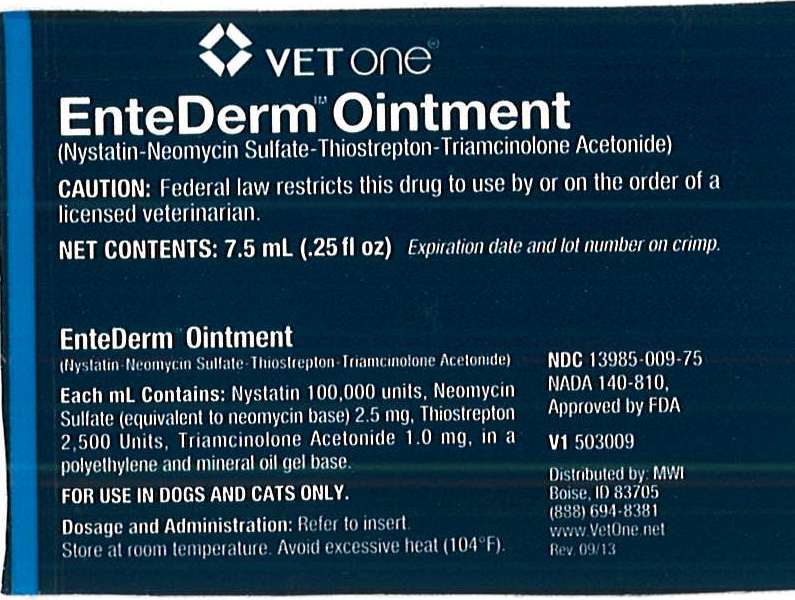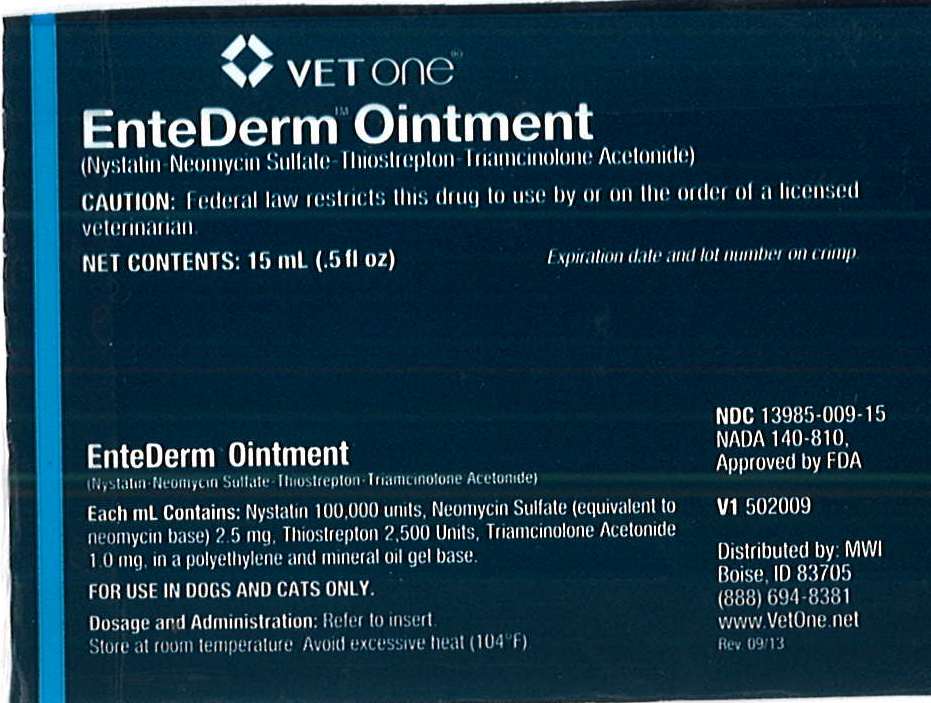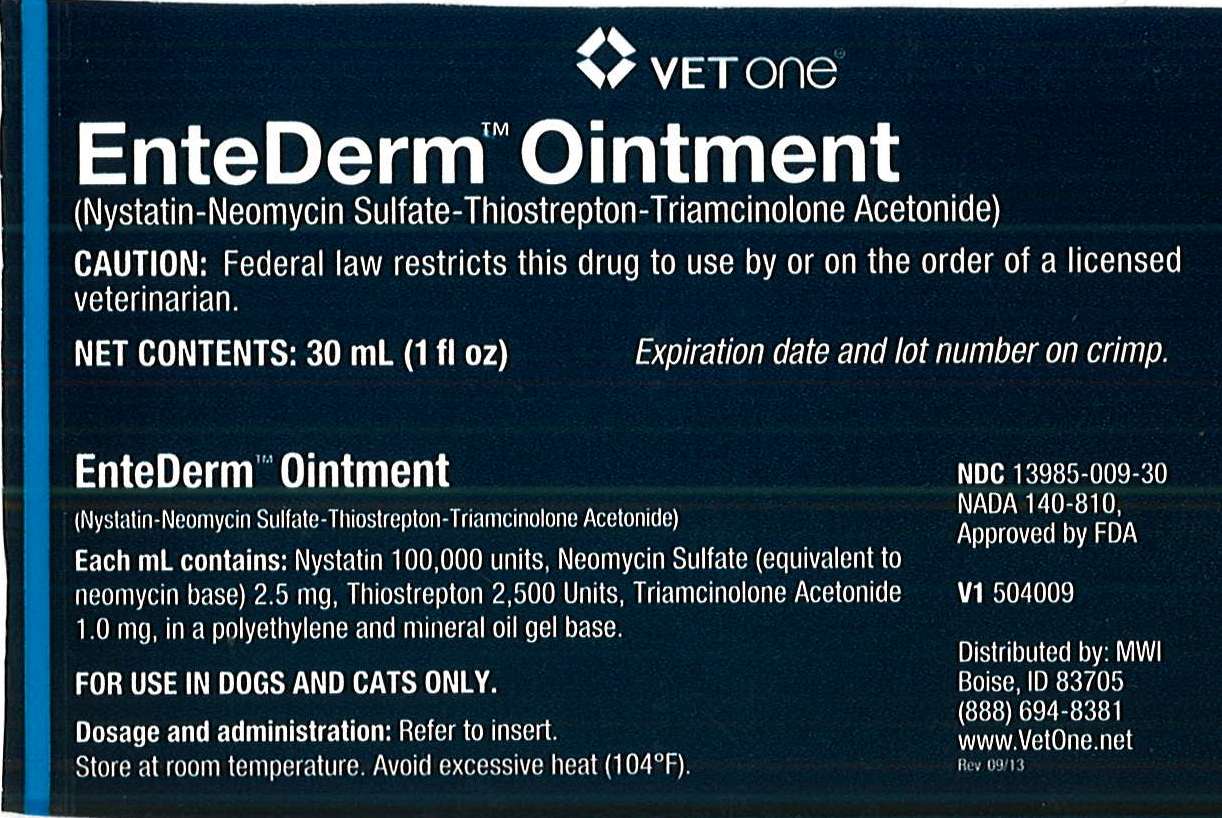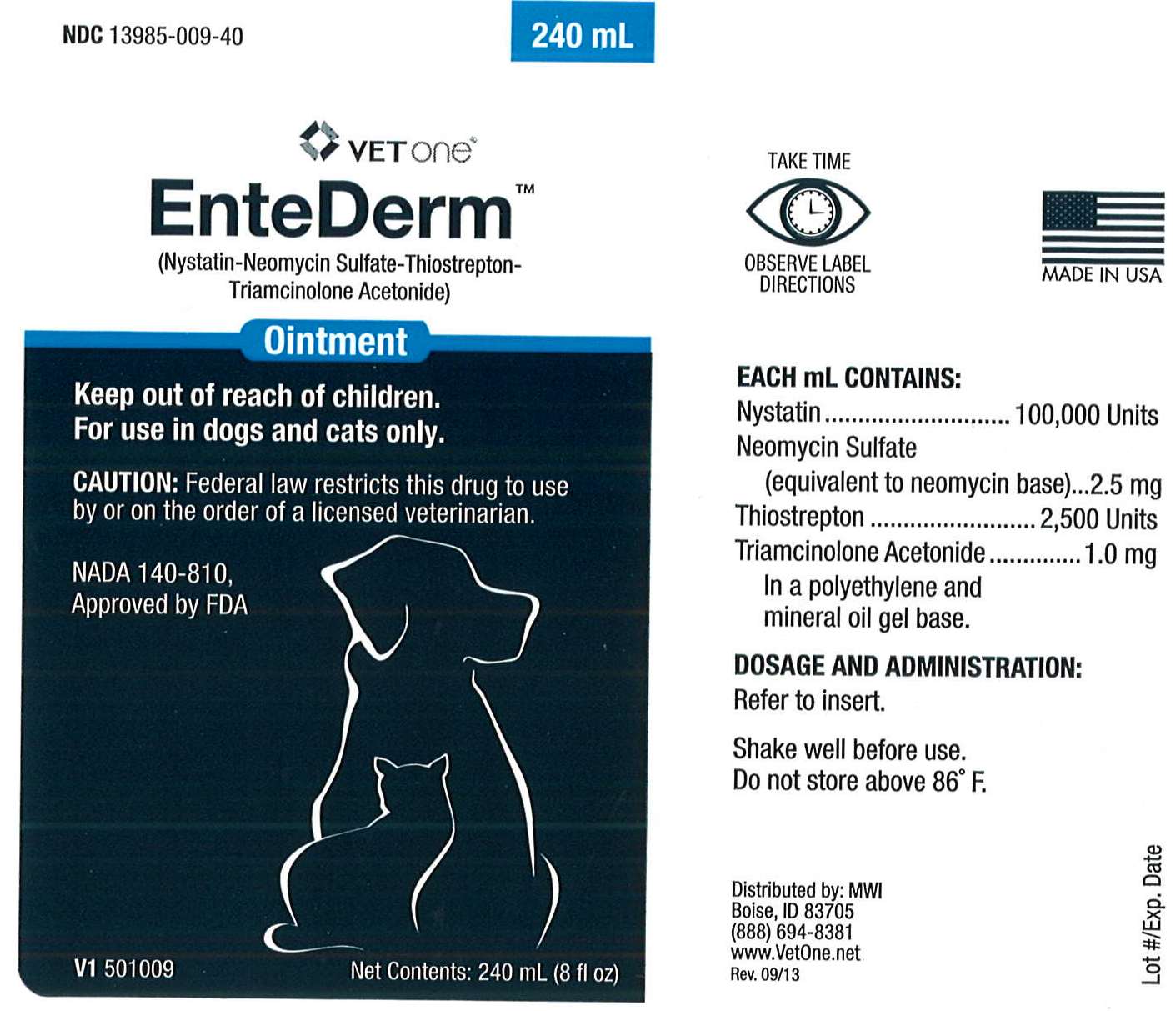Animal NDC 13985-009-30 Entederm
Nystatin, Neomycin Sulfate, Thiostrepton And Triamcinolone Acetonide
Animal Product Information
Entederm Animal Product Labeling Information
The product labeling information includes all published material associated to a drug. Product labeling documents include information like generic names, active ingredients, ingredient strength dosage, routes of administration, appearance, usage, warnings, inactive ingredients, etc.
Table of Contents
Description
For Use Only in Dogs and Cats NADA 140-810, Approved by FDA.
CAUTION: Federal law restricts this drug to use by or on the order of a licensed veterinarian.
DESCRIPTION:
Nystatin, neomycin sulfate, thiostrepton and triamcinolone acetonide ointment is an ointment in a non-irritating vehicle, a polyethylene and mineral oil gel base.
Each mL contains:
nystatin 100,000 units
neomycin sulfate (equivalent to neomycin base) 2.5 mg
thiostrepton 2,500 units
triamcinolone acetonide 1.0 mg
Nystatin, neomycin sulfate, thiostrepton and triamcinolone acetonide ointment is supplied in tubes of 1/4 fl.oz. (7.5 mL.), 1/2 fl. oz. (15 mL.), and 1 fl. oz. (30 mL.), each with an elongated tip for easy application and in dispensing bottles of 8 fl. oz. (240 mL.). The preparation is intended for local therapy in a variety of cutaneous disorders of cats and dogs; it is especially useful in disorders caused, complicated, or threatened by bacterial and/or candidal (monilial) infections.
ACTIONS:
By virtue of its four active ingredients, the ointment provides four basic therapeutic effects: anti-inflammatory, antipruritic, antifungal and antibacterial. Triamcinolone acetonide is a potent synthetic corticosteroid providing rapid and prolonged symptomatic relief on topical administration. Inflammation, edema, and pruritis promptly subside and lesions are permitted to heal. Nystatin is the first well tolerated anti-fungal antibiotic of dependable efficacy for the treatment of cutaneous infections caused by Candida albicans (monilia). Nystatin is fungistatic in vitro against a variety of yeast and yeast-like fungi including many fungi pathogenic to animals. No appreciable activity is exhibited against bacteria. Thiostrepton has a high order of activity against gram-positive organisms, including many which are resistant to other antibiotics; neomycin exerts antimicrobial action against a wide range of gram-positive and gram-negative bacteria. Together they provide comprehensive therapy against those organisms responsible for most superficial bacterial infections.
Indications & Usage
INDICATIONS:
Nystatin, neomycin sulfate, thiostrepton and triamcinolone acetonide ointment is particularly useful in the treatment of acute and chronic otitis of varied etiologies, in interdigital cysts in cats and dogs, and in anal gland infections in dogs. The preparation is also indicated in the management of dermatologic disorders characterized by inflammation and dry or exudative dermatitis, particularly those caused, complicated, or threatened by bacterial or candidal (Candida albicans) infections. It is also of value in eczematous dermatitis; contact dermatitis, and seborrheic dermatitis; and as an adjunct in the treatment of dermatitis due to parasitic infestation.
Warnings And Precautions
WARNINGS:
Clinical and experimental data have demonstrated that corticosteroids administered orally or by injection to animals may induce the first stage of parturition if used during the last trimester of pregnancy and may precipitate premature parturition followed by dystocia, fetal death, retained placenta, and metritis.
Additionally, corticosteroids administered to dogs, rabbits and rodents during pregnancy have resulted in cleft palate in the offspring. In dogs, other congenital anomalies have resulted; deformed forelegs, phocomelia, and anasarca.
PRECAUTIONS:
Nystatin, neomycin sulfate, thiostrepton and triamcinolone acetonide ointment is not intended for the treatment of
deep abscesses or deep-seated infections such as inflammation of the
lymphatic vessels. Parenteral antibiotic therapy is indicated in these
infections.
Nystatin, neomycin sulfate, thiostrepton and triamcinolone acetonide ointment has been
extremely well tolerated. Cutaneous reactions attributable to its use
have been extremely rare. The occurrence of systemic reactions is
rarely a problem with topical administration.
There is some evidence that corticosteroids can be absorbed after topical application and cause systemic effects. Therefore, an animal receiving nystatin, neomycin sulfate, thiostrepton and triamcinolone acetonide ointment therapy should be observed closely for signs such as polydipsia, polyuria, and increased weight gain. Nystatin, neomycin sulfate, thiostrepton and triamcinolone acetonide ointment is not generally recommended for the treatment of deep or puncture wounds or serious burns.
Sensitivity to neomycin may occur. If redness, irritation or swelling persists or increases, discontinue use. Do not use if pus is present since the drug may allow the infection to spread. Keep this and all medications out of the reach of children.
Avoid ingestion. Oral or parenteral use of corticosteroids (depending on dose, duration of use, and specific steroid) may result in inhibition of endogenous steroid production following drug withdrawal.
SIDE EFFECTS:
SAP and
SGPT (ALT) enzyme elevations, polydipsia/polyuria, vomiting, and
diarrhea (occasionally bloody) have been observed following parenteral
or systemic use of synthetic corticosteroids in dogs.
Cushing's
syndrome has been reported in association with prolonged or repeated
steriod therapy in dogs.
Temporary hearing loss has been reported in
conjunction with treatment of otitis with products containing
corticosteroids. However, regression usually occurred following
withdrawal of the drug. If hearing dysfunction is noted during the
course of treatment with nystatin, neomycin sulfate, thiostrepton and triamcinolone acetonide ointment, discontinue its use.
CAUTION:
Before instilling any medication into the ear, examine the external ear canal thoroughly to be certain the tympanic membrane is not ruptured in order to avoid the possibility of transmitting infection to the middle ear as well as damaging the cochlea or vestibular apparatus from prolonged contact. If hearing or vestibular dysfunction is noted during the course of treatment, discontinue the use of nystatin, neomycin sulfate, thiostrepton and triamcinolone acetonide ointment.
Dosage & Administration
DOSAGE AND ADMINISTRATION:
Frequency of administration is dependent on the severity of the condition. For mild inflammations, application may range from once daily to once a week; for severe conditions nystatin, neomycin sulfate, thiostrepton and triamcinolone acetonide ointment may be applied as often as two to three times daily, if necessary. Frequency of treatment may be decreased as improvement occurs.
Wear gloves during the administration of the ointment or wash hands immediately after application.
OTITIS: Clean ear canal of impacted cerumen. Inspect canal and remove any foreign bodies such as grass awns, ticks, etc. Instill three to five drops of nystatin, neomycin sulfate, thiostrepton and triamcinolone acetonide ointment.
Preliminary use of a local anesthetic such as Proparacaine Hydrochloride Ophthalmic Solution may be advisable.
INFECTED ANAL GLANDS, CYSTIC AREAS, ETC: Drain gland or cyst and then fill with nystatin, neomycin sulfate, thiostrepton and triamcinolone acetonide ointment.
OTHER DERMATOLOGIC DISORDERS: Clean affected areas, removing any encrusted discharge or exudate. Apply nystatin, neomycin sulfate, thiostrepton and triamcinolone acetonide ointment sparingly in a thin film.
Storage And Handling
STORAGE:
240 mL bottle: Do not store above 86°F. 7.5 mL, 15 mL, 30 mL tubers: Store at room temperature; avoid excessive heat (104°F).
Manufactured by Med-Pharmex, Inc.
Pomona, CA 91767
Revised 10/98
Package Label.Principal Display Panel
* The information on this page is for an ANIMAL PRODUCT, please review the complete disclaimer below.



